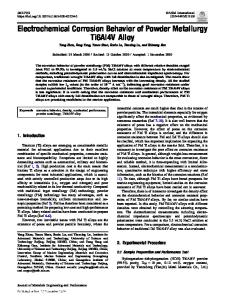Pitting corrosion behavior of powder metallurgy mechanically alloyed in-9052
- PDF / 1,710,406 Bytes
- 4 Pages / 597 x 774 pts Page_size
- 79 Downloads / 397 Views
J.F. MclNTYRE, formerly with the Naval Surface Warfare Center, is Assistant Professor, Department of Ocean Engineering, Florida Atlantic University, Boca Raton, FL 33433. R.K. GARREq~, Jr., Materials Engineer, Metallic Materials Branch, and R.K. CONRAD, Research Chemist, Electrochemistry Branch, are with the Naval Surface Warfare Center, Silver Spring, MD 20903-5000. Manuscript submitted June 29, 1989. 938--VOLUME 22A, APRIL 1991
mer. All samples were wet ground to a 600 SiC grit finish and degreased in acetone, followed by a methanol rinse prior to exposure. Microstructures for each alloy are shown in Figure 1, and elemental compositions are provided in Table I. Electrode potentials are reported with respect to the saturated calomel electrode. A three-electrode cell arrangement was used for all electrochemical measurements. Pitting susceptibility was determined using potentiodynamic and potentiostatic techniques. Potentiodynamic scans were started at open circuit potential (Eocp) and scanned in the anodic direction at a rate of 0.2 mV/s. The pitting potential (Ep) was taken to be that potential where the anodic current, increased rapidly. Solutions were deaerated with purified nitrogen for 3 hours prior to sampie introduction, and deaeration was continued during the test. For potentiodynamic pitting tests, samples were exposed to deaerated 3.5 wt pct NaCI for 1 hour prior to the testing. A potentiostatic technique was used to study the kinetics of pitting. Samples were immersed in deaerated 3.5 wt pct NaC1 for 15 minutes before polarization to 1 to 2 mV above Ep (Ep values were determined in separate potentiostatic tests). The applied potential was held for 17 hours while the change in current with time was recorded. Scanning electron microscopy (SEM) was used to study the morphology of pit development for freely corroding samples exposed to 3.5 wt pct NaC1 for 5 weeks under ambient conditions. The samples were examined before removal of the corrosion product film and then re-examined after removal of this layer with dilute NaOH. A summary of the potentiodynamic pitting potentials can be seen in Table II. The Ep values for the three alloys are similar; however, based on the difference between Ep and Eocp, IN-9052 should be somewhat more resistant to pitting. The absolute value of Ep is not the best measure of the pitting resistance. Pitting resistance is better determined by the difference between Ep and Eocp (AE). An alloy will not spontaneously pit until the Eocphas exceeded Ep; hence, the greater the separation between Ep and Eo~p, the more resistant that alloy will be to pit initiation. Therefore, a small AE would suggest that less stringent perturbations are required to drive Eo~p above Ep to initiate pitting. Wiggle et al. I14] also used this difference between Eo~p and Ep as a measure of pitting resistance in their studies on the influence of inhibitors on the pitting behavior of AA-3003. Potentiostatic pitting tests were conducted to investigate the kinetics of pit initiation. The current density for AA-6
Data Loading...











